2017年人版小学四年级(上册)英语重点难点
- 格式:doc
- 大小:170.28 KB
- 文档页数:10
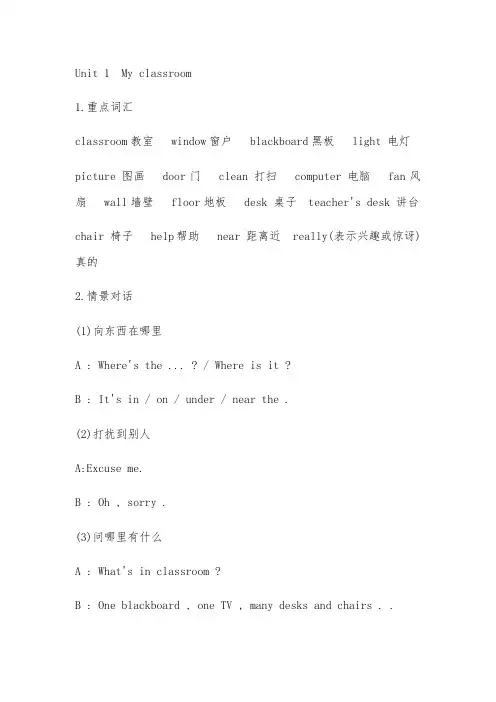
Unit 1 My classroom1.重点词汇classroom教室 window窗户 blackboard黑板 light 电灯picture 图画 door门 clean 打扫 computer 电脑 fan风扇 wall墙壁 floor地板 desk 桌子 teacher's desk 讲台chair 椅子 help帮助 near 距离近 really(表示兴趣或惊讶)真的2.情景对话(1)向东西在哪里A : Where's the ... ? / Where is it ?B : It's in / on / under / near the .(2)打扰到别人A:Excuse me.B : Oh , sorry .(3)问哪里有什么A : What's in classroom ?B : One blackboard , one TV , many desks and chairs . .(4)帮助某人A : Let me help you .B:Thank you.(5)让我们一起做什么A:Let us clean the blackboard.(注:let us= let’s) B:Ok/ Sure/Great.3.重点句子(1)Let me clean the...让我来打扫...(2)Let's clean the...一起来打扫...(3)Open the door.打开门Close the door .关上门。
(4)Turn on the light.打开电灯。
(5)Close the window.关上窗户。
Open the window.打开窗户(6)Put up the picture .张贴图画。
(7)Clean the blackboard.擦黑板。
注意the 的使用Unit 2 My schoolbag1.重点词汇schoolbag书包 heavy重的 notebook笔记本 maths book数学书storybook故事书 English book英语书 Chinese book 语文书key钥匙 toy玩具 candy糖果 cute有趣的 so much非常地lost丢失(lose的过去式形式) full 饱注意数学书、英语书、语文书是短语,书包、笔记本、故事书是单词,书写的时候一定要注意。
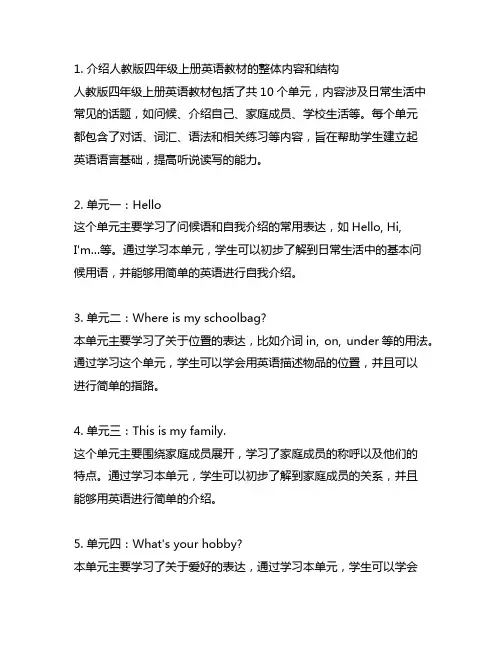
1. 介绍人教版四年级上册英语教材的整体内容和结构人教版四年级上册英语教材包括了共10个单元,内容涉及日常生活中常见的话题,如问候、介绍自己、家庭成员、学校生活等。
每个单元都包含了对话、词汇、语法和相关练习等内容,旨在帮助学生建立起英语语言基础,提高听说读写的能力。
2. 单元一:Hello这个单元主要学习了问候语和自我介绍的常用表达,如Hello, Hi,I'm…等。
通过学习本单元,学生可以初步了解到日常生活中的基本问候用语,并能够用简单的英语进行自我介绍。
3. 单元二:Where is my schoolbag?本单元主要学习了关于位置的表达,比如介词in, on, under等的用法。
通过学习这个单元,学生可以学会用英语描述物品的位置,并且可以进行简单的指路。
4. 单元三:This is my family.这个单元主要围绕家庭成员展开,学习了家庭成员的称呼以及他们的特点。
通过学习本单元,学生可以初步了解到家庭成员的关系,并且能够用英语进行简单的介绍。
5. 单元四:What's your hobby?本单元主要学习了关于爱好的表达,通过学习本单元,学生可以学会用英语描述自己的爱好,并且可以询问别人的爱好。
6. 单元五:I love animals.这个单元主要围绕动物展开,学习了动物的名称以及它们的特点。
通过学习本单元,学生可以初步了解到各种常见动物,并且能够用英语进行描述。
7. 单元六:My birthday本单元主要学习了关于生日的表达,比如日期、庆祝方式等。
通过学习这个单元,学生可以学会用英语描述自己的生日,并且可以询问别人的生日。
8. 单元七:What's the time?这个单元主要学习了关于时间的表达,比如钟点、星期、日期等。
通过学习本单元,学生可以学会用英语询问时间,并且能够进行简单的时间表达。
9. 单元八:What's the weather like today?本单元主要学习了关于天气的表达,比如晴天、阴天、雨天、雪天等。

人教版4上英语重点人教版4上英语的重点内容如下:1. Unit 1: Nice to meet you!- Greetings and introductions- Vocabulary: hobbies, likes and dislikes- Sentence patterns: "What's your name?" "My name is..."- Grammar: present simple tense with frequency adverbs2. Unit 2: How do you go to school?- Vocabulary: transportation methods, places in a city- Sentence patterns: "How do you go to...?" "I go by..."- Grammar: prepositions of place (in, on, at), object pronouns (me, him, her, us), plural nouns3. Unit 3: Where are you from?- Vocabulary: countries, nationalities, languages- Sentence patterns: "Where are you from?" "I'm from..."- Grammar: verb "to be" (am, is, are), possessive pronouns (my, his, her, our)4. Unit 4: I have a pen pal.- Vocabulary: household items, pen pals, daily routines- Sentence patterns: "Do you have a...?" "Yes, I do. / No, I don't."- Grammar: present simple tense, plural nouns, third person singular5. Unit 5: Our classroom rules.- Vocabulary: school subjects, classroom objects, rules- Sentence patterns: "What do you have on...?" "We have..."- Grammar: questions with "What", imperatives, imperative sentences with "Let's"6. Unit 6: What's this in English?- Vocabulary: classroom objects, stationery, food- Sentence patterns: "What's this in English?" "It's a..."- Grammar: singular and plural nouns, possessive case (John's book)以上是人教版4上英语的重点内容,希望能对你有所帮助!。
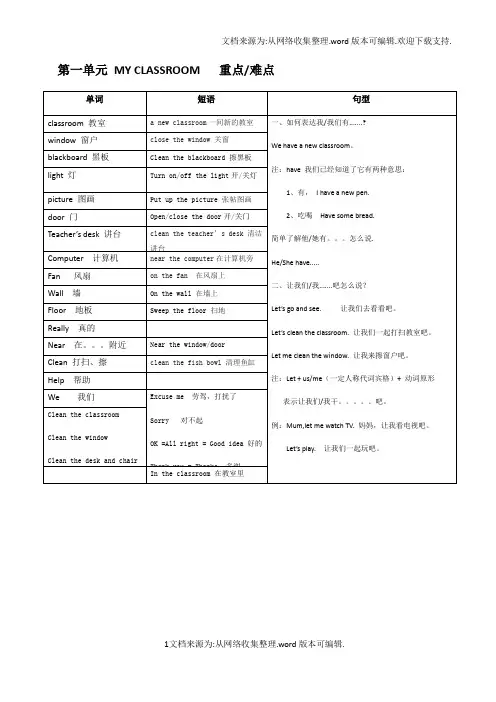
第一单元MY CLASSROOM 重点/难点第二单元My schoolbag重点/难点第三单元My friends重点/难点第四单元My home(我的家)重点/难点第五单元Dinner’s ready (晚餐准备好了)重点/难点第六单元Meet my family(见一见我的家人)重点/难点注释一、缩写和全称what’s = what is 是什么 let’s = let us 让我们where’s = where is 在哪里 he’s = he is 他是 she’s = she is 她是they’re = they are 他们是 you’re = you are 你是 it’s = it is它是aren’t = are not不是 isn’t = is not不是 I’d = I would 我···Can’t = can not 不能 I am = I’m 我是 we are = we’re 我们是There are =there’re there is = there’s 那儿有.. Tom is = Tom’s 汤姆的Have not = haven’t has not =hasn’t 没有 that is = that’s 那是...二、数字one一 two二 three三 four四 five五 six六 seven七 eight 八nine九 ten十 eleven十一 twelve 十二 (一至十二单独记)thirteen十三 fourteen 十四 fifteen十五 sixteen十六 seventeen十七eighteen 十八 nineteen 十九(十几后面都有teen,thirteen, fifteen, eighteen 特殊记)twenty 二十 thirty三十 forty 四十 fifty 五十 sixty六十 seventy 七十eighty八十 ninety 九十(几十后面都加ty,twenty不同重点记。
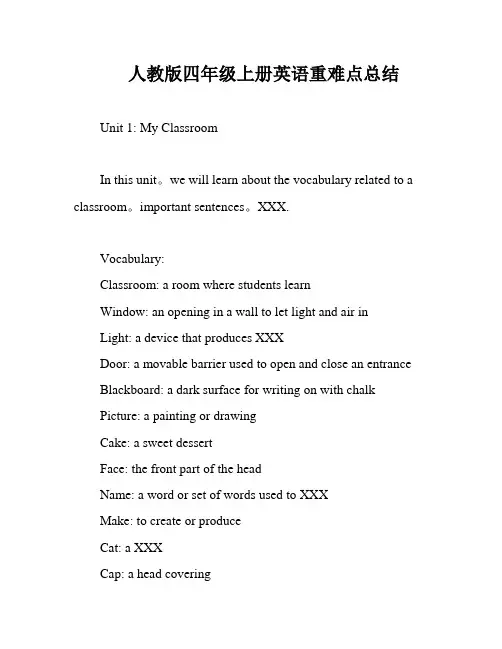
人教版四年级上册英语重难点总结Unit 1: My ClassroomIn this unit。
we will learn about the vocabulary related to a classroom。
important sentences。
XXX.Vocabulary:Classroom: a room where students learnWindow: an opening in a wall to let light and air inLight: a device that produces XXXDoor: a movable barrier used to open and close an entrance Blackboard: a dark surface for writing on with chalkPicture: a painting or drawingCake: a sweet dessertFace: the front part of the headName: a word or set of words used to XXXMake: to create or produceCat: a XXXCap: a head coveringFloor: the surface of a room on which one standsNear: close in distanceXXX's desk: a desk used by a XXXComputer: an electronic device used for processing data Fan: a device used to create a current of airWall: a vertical structure used to enclose an areaDesk: a piece of furniture with a flat top and one or more drawersChair: a seat for one personXXX:1.We have a new classroom.2.What's in the classroom?3.Let's go and see!4.Let me clean the windows.5.Where is it?6.It's near the window.7.XXX.8.XXX on the light.the window.10.Put up the picture.11.XXX.Dialogues:1.Q: Where is the bee?A: It's in/on/under/near the wall.2.Q: What's this?A: It's a bee.3.Q: What color is your desk?A: It's green.4.Q: How many chairs are there in the classroom?A: There are forty.Grammar:XXX by adding "s" when there is more than one of the same item。
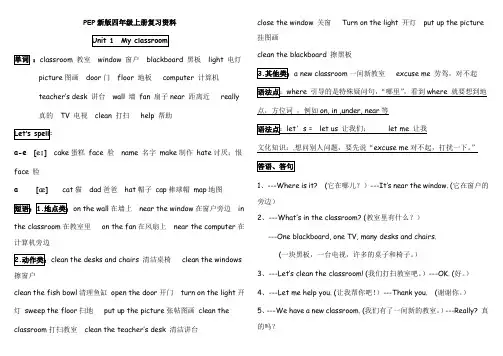
PEP新版四年级上册复习资料:classroom 教室window 窗户blackboard 黑板light 电灯picture图画door门floor 地板computer 计算机teacher’s desk 讲台wall 墙fan 扇子near 距离近really真的TV 电视clean 打扫help 帮助a-e [eɪ] cake蛋糕face 脸name 名字make制作hate讨厌;恨face 脸a [æ] cat猫dad爸爸hat帽子cap棒球帽map地图on the wall在墙上near the window在窗户旁边inthe classroom在教室里on the fan在风扇上near the computer在计算机旁边clean the desks and chairs 清洁桌椅clean the windows 擦窗户clean the fish bowl清理鱼缸open the door开门turn on the light开灯sweep the floor扫地put up the picture张帖图画clean the classroom打扫教室clean the teacher’s desk 清洁讲台close the window 关窗Turn on the light 开灯put up the picture 挂图画clean the blackboard 擦黑板a new classroom一间新教室excuse me 劳驾,对不起点,方位词,例如on, in ,under, near等文化知识:.想问别人问题,要先说“excuse me对不起,打扰一下。
”1、---Where is it? (它在哪儿?)---It’s near the window. (它在窗户的旁边)2、---What’s in the classroom? (教室里有什么?)---One blackboard, one TV, many desks and chairs.(一块黑板,一台电视,许多的桌子和椅子。
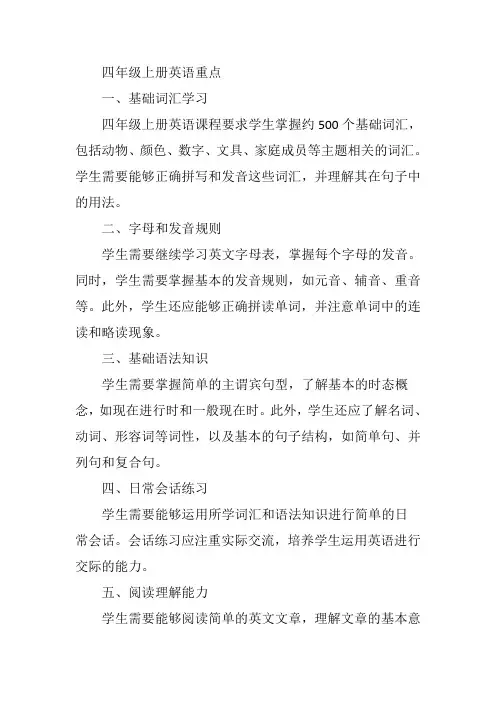
四年级上册英语重点
一、基础词汇学习
四年级上册英语课程要求学生掌握约500个基础词汇,包括动物、颜色、数字、文具、家庭成员等主题相关的词汇。
学生需要能够正确拼写和发音这些词汇,并理解其在句子中的用法。
二、字母和发音规则
学生需要继续学习英文字母表,掌握每个字母的发音。
同时,学生需要掌握基本的发音规则,如元音、辅音、重音等。
此外,学生还应能够正确拼读单词,并注意单词中的连读和略读现象。
三、基础语法知识
学生需要掌握简单的主谓宾句型,了解基本的时态概念,如现在进行时和一般现在时。
此外,学生还应了解名词、动词、形容词等词性,以及基本的句子结构,如简单句、并列句和复合句。
四、日常会话练习
学生需要能够运用所学词汇和语法知识进行简单的日
常会话。
会话练习应注重实际交流,培养学生运用英语进行交际的能力。
五、阅读理解能力
学生需要能够阅读简单的英文文章,理解文章的基本意
思,并回答与文章相关的问题。
阅读材料应符合学生的认知水平,难度适中,培养学生的阅读兴趣和习惯。
六、写作表达能力
学生需要能够运用所学词汇和语法知识进行简单的英文写作。
写作练习可以包括写日记、写信、写故事等不同形式,培养学生的写作兴趣和表达能力。
七、课堂活动参与
学生应积极参与课堂活动,如角色扮演、小组讨论、游戏等。
通过多样化的课堂活动,激发学生的学习兴趣和积极性,提高他们的英语应用能力。
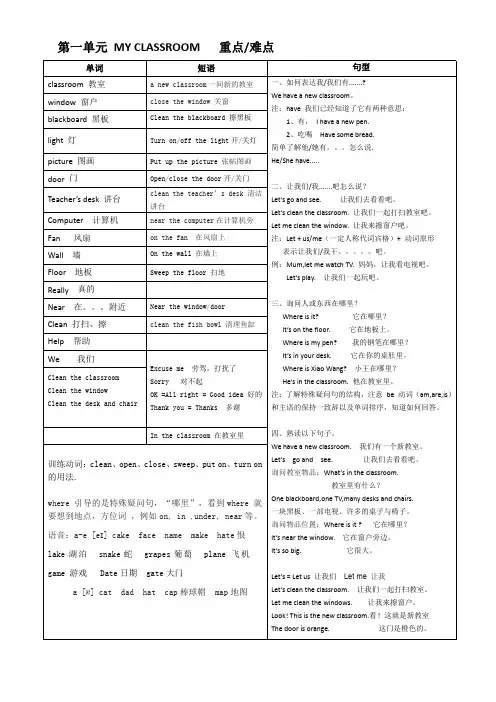
第一单元MY CLASSROOM重点/难点第二单元My schoolbag重点/难点第三单元My friends重点/难点第四单元My home(我的家)重点/难点第五单元Dinner’s ready(晚餐准备好了)重点/难点第六单元Meet my family(见一见我的家人)重点/难点注释一、缩写和全称what’s=what is是什么let’s=let us让我们where’s=where is在哪里he’s=he is他是she’s=she is她是they’re=they are他们是you’re=you are你是it’s=it is它是aren’t=are not不是isn’t=is not不是I’d=I would我···Can’t=can not不能I am=I’m我是we are=we’re我们是There are=there’re there is=there’s那儿有..Tom is=Tom’s汤姆的Have not=haven’t has not=hasn’t没有that is=that’s那是...二、数字one一two二three三four四five五six六seven七eight八nine九ten十eleven十一twelve十二(一至十二单独记)thirteen十三fourteen十四fifteen十五sixteen十六seventeen十七eighteen十八nineteen十九(十几后面都有teen,thirteen,fifteen,eighteen特殊记)twenty二十thirty三十forty四十fifty五十sixty六十seventy七十eighty八十ninety九十(几十后面都加ty,twenty不同重点记。
forty去掉字母u,thirty,fifty更出奇。
)要说几十几,就在几十后面加上几:如:twenty one21twenty two22twenty three23....thirty one31 thirty six36.....forty four44.....三、颜色blue蓝色green绿色purple紫色yellow黄色red红色pink粉红色black黑色white白色brown棕色orange橙色yellow黄色purple紫色,grey(gray)灰色golden金色silver银色主讲“be动词”与人称代词的搭配1、基本形式:am、are、is(1)Am第一人称I+am(注意:“I”无论何时都要大写,不管位于句首还是句中)例:I am a beautiful girl.I am twenty.(2)Are第二人称you+are;第一人称复数we+are;第三人称复数they+are;其他复数名词+are(注意:第二人称单复数同形,都为you)例:You are my good friend.We are in the same class.They are on the road.The books are on the desk.(3)is第三人称he(男)+is;she(女)+is;it(不是人)+is;其他单数名词+is 例:He\She is a good student.It is a white cat.A dog is on that street.2、肯定、否定、疑问(等于号后是简写)肯定否定——be动词后加not一般疑问——be动词移到主语前一般疑问否定一般疑问回答肯定和否定I am…=I’m….I am not…=I’mnot...Am I…?Am not I…?Yes,I’m.No,I’m not.You are=you’re You are not=Youaren’t…Are you…?Are not you...?=Aren’t you…?Yes,you are.No,you are not.She\He\It is…=She\He\It is not…=She\He\It isn’t…Is she\he\it…?Is notshe\he\it…?=Isn’tshe\he\it…?Yes,she\he\It is.No,she\he\It isnot.We are=We’re We are not…=Wearen’t…Are we…?Are not we…?=Aren’t we…?Yes,we are.No,we are not.They are=They’reThey arenot…=Theyaren’tAre they…?Are not they…?=Aren’t they…?Yes,they are.No,they are not.例:I am(not)from London.My eyes are(not)small.My hair is(not)long.例:1、Am I a Chinese?Yes,you are.肯定回答/No,you aren’t.否定回答2、Is the cat fat?Yes,it is.肯定回答/No,it isn’t.否定回答注意:在一般疑问回答中,肯定回答除I’m不可简写,否定回答均可简写。
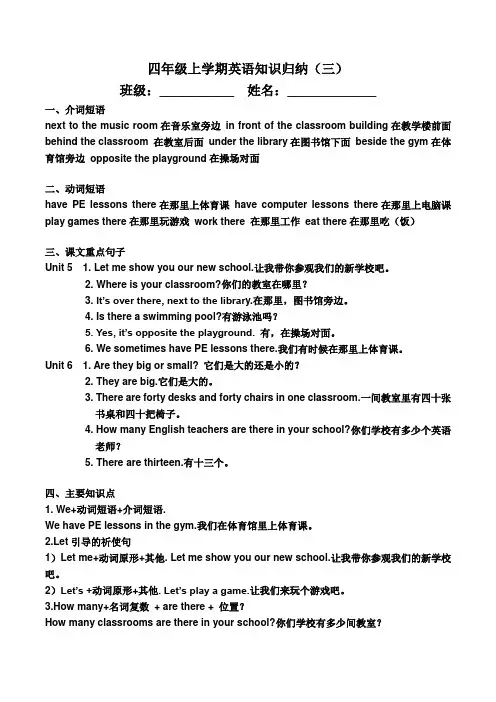
四年级上学期英语知识归纳(三)班级:__________ 姓名:____________一、介词短语next to the music room在音乐室旁边in front of the classroom building在教学楼前面behind the classroom 在教室后面under the library在图书馆下面beside the gym在体育馆旁边opposite the playground在操场对面二、动词短语have PE lessons there在那里上体育课have computer lessons there在那里上电脑课play games there在那里玩游戏work there 在那里工作eat there在那里吃(饭)三、课文重点句子Unit 5 1. Let me show you our new school.让我带你参观我们的新学校吧。
2. Where is your classroom?你们的教室在哪里?3. It’s over there, next to the librar y.在那里,图书馆旁边。
4. Is there a swimming pool?有游泳池吗?5. Yes, it’s opposite the playground. 有,在操场对面。
6. We sometimes have PE lessons there.我们有时候在那里上体育课。
Unit 6 1. Are they big or small? 它们是大的还是小的?2. They are big.它们是大的。
3. There are forty desks and forty chairs in one classroom.一间教室里有四十张书桌和四十把椅子。
4. How many English teachers are there in your school?你们学校有多少个英语老师?5. There are thirteen.有十三个。
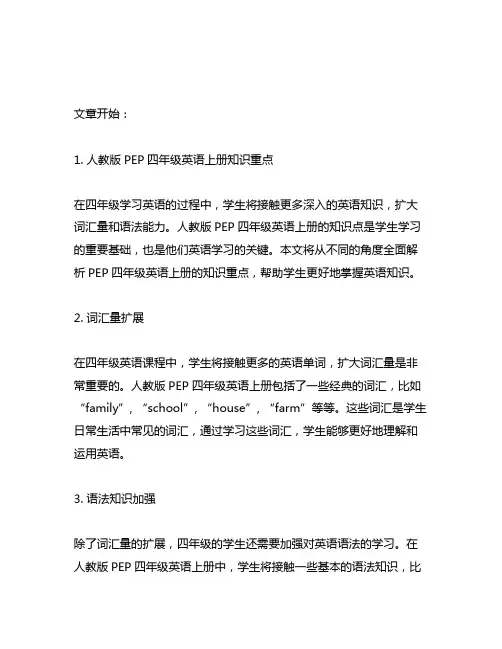
文章开始:1. 人教版PEP四年级英语上册知识重点在四年级学习英语的过程中,学生将接触更多深入的英语知识,扩大词汇量和语法能力。
人教版PEP四年级英语上册的知识点是学生学习的重要基础,也是他们英语学习的关键。
本文将从不同的角度全面解析PEP四年级英语上册的知识重点,帮助学生更好地掌握英语知识。
2. 词汇量扩展在四年级英语课程中,学生将接触更多的英语单词,扩大词汇量是非常重要的。
人教版PEP四年级英语上册包括了一些经典的词汇,比如“family”, “school”, “house”, “farm”等等。
这些词汇是学生日常生活中常见的词汇,通过学习这些词汇,学生能够更好地理解和运用英语。
3. 语法知识加强除了词汇量的扩展,四年级的学生还需要加强对英语语法的学习。
在人教版PEP四年级英语上册中,学生将接触一些基本的语法知识,比如动词的时态、名词的单复数等等。
这些语法知识的掌握对学生后续英语学习的能力有着非常重要的作用,因此需要特别重视。
4. 听力和口语训练在学习英语的过程中,听力和口语训练同样至关重要。
人教版PEP四年级英语上册中包括了大量的听力和口语练习,帮助学生提高他们的听力和口语能力。
通过这些练习,学生能够更好地理解和运用英语,提高他们的英语交流能力。
总结回顾:通过全面的分析,我们可以看到人教版PEP四年级英语上册的知识重点包括词汇量扩展、语法知识加强以及听力和口语训练。
这些知识点对学生的英语学习起着至关重要的作用。
在学习过程中,学生需要重点关注这些知识点,加强练习和巩固,从而更好地掌握英语知识,提高他们的英语能力。
个人观点和理解:我认为人教版PEP四年级英语上册的知识重点非常重要,对学生的英语学习起着至关重要的作用。
在学习过程中,学生需要注重词汇量的扩展、语法知识的加强以及听力和口语训练,从而提高他们的英语能力。
只有在这些知识点上下功夫,才能够更好地掌握英语知识,实现英语学习的目标。
希望我写的这篇文章可以帮助你更好地理解人教版PEP四年级英语上册的知识重点,并且在英语学习的过程中能够更加得心应手。
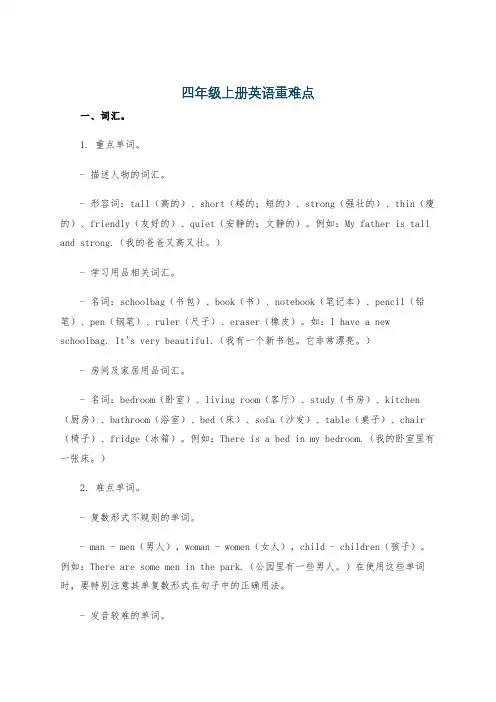
四年级上册英语重难点一、词汇。
1. 重点单词。
- 描述人物的词汇。
- 形容词:tall(高的)、short(矮的;短的)、strong(强壮的)、thin(瘦的)、friendly(友好的)、quiet(安静的;文静的)。
例如:My father is tall and strong.(我的爸爸又高又壮。
)- 学习用品相关词汇。
- 名词:schoolbag(书包)、book(书)、notebook(笔记本)、pencil(铅笔)、pen(钢笔)、ruler(尺子)、eraser(橡皮)。
如:I have a new schoolbag. It's very beautiful.(我有一个新书包。
它非常漂亮。
)- 房间及家居用品词汇。
- 名词:bedroom(卧室)、living room(客厅)、study(书房)、kitchen (厨房)、bathroom(浴室)、bed(床)、sofa(沙发)、table(桌子)、chair (椅子)、fridge(冰箱)。
例如:There is a bed in my bedroom.(我的卧室里有一张床。
)2. 难点单词。
- 复数形式不规则的单词。
- man - men(男人),woman - women(女人),child - children(孩子)。
例如:There are some men in the park.(公园里有一些男人。
)在使用这些单词时,要特别注意其单复数形式在句子中的正确用法。
- 发音较难的单词。
- “window”中的“ow”发[əʊ],有些学生可能会发错音。
可以通过多听、多读来纠正,如:The window is big.(这个窗户很大。
)二、句型。
1. 重点句型。
- 描述人物外貌或性格特征的句型。
- 主语+be动词(am/is/are)+形容词。
例如:He is tall and strong.(他又高又壮。
)She is quiet.(她很文静。
2017新人教版PEP四年级英语上册各单元知识点总结2017新人教版PEP四年级英语上册各单元知识点总结编辑整理:尊敬的读者朋友们:这里是精品文档编辑中心,本文档内容是由我和我的同事精心编辑整理后发布的,发布之前我们对文中内容进行仔细校对,但是难免会有疏漏的地方,但是任然希望(2017新人教版PEP四年级英语上册各单元知识点总结)的内容能够给您的工作和学习带来便利。
同时也真诚的希望收到您的建议和反馈,这将是我们进步的源泉,前进的动力。
本文可编辑可修改,如果觉得对您有帮助请收藏以便随时查阅,最后祝您生活愉快业绩进步,以下为2017新人教版PEP四年级英语上册各单元知识点总结的全部内容。
computer teacher’s desk wall fan TV near really clean helpLet's spell:a-e [eɒ] cake蛋糕 face 脸 name 名字 make制作 hate讨厌;恨 f ace 脸a [æ] cat猫 dad爸爸 hat帽子 cap棒球帽 map地图句型:询问教室物品:What's in the classroom? One blackboard, one TV, manydesks and chairs。
询问物品位置:Where is it ? It’s near the window。
We have a new classroom. Let’s go and see。
It’s so big。
Let’s clean the classroom。
Let me clean the windows. .Look! This is the new classroom。
The door is orange。
短语:1.地点类:on the wall在墙上 near the window在窗户旁边 in the classroom在教室里on the fan在风扇上 near the computer在计算机旁边2. 动作类:clean the desks and chairs 清洁桌椅 clean the windows擦窗户 clean the fish bowl清理鱼缸 open the door开门 turn on the light开灯 sweep the floor扫地 put up the picture张帖图画 clean the classroom打扫教室 clean the teacher’s desk 清洁讲台 close the window 关窗 Turn on the light 开灯 put up the picture 挂图画 clean the blackboard 擦黑板3.其他类:a new classroom一间新教室 excuse me 劳驾,对不起语法点:where 引导的是特殊疑问句,“哪里",看到where 就要想到地点方位词, 例on, in ,under, near等语法点:let’s = let us 让我们; let me 让我文化知识:.想问别人问题,要先说“excuse me对不起,打扰一下.”答语、答句1、—-—-—-Where is it? —-—--—It’s near the window.2、——---What’s in the classroom? ——-——One blackboard, one TV, many desks and chairs.3、-----Let’s clean the classroom! —-———OK。
人教版四年级上册英语知识点包括但不限于:
1. 词汇:包括各种与学校、家庭、动物、颜色等相关的词汇。
例如,教室(classroom)、窗户(window)、黑板(blackboard)、电灯(light)、图画(picture)、门(door)、地板(floor)、计算机(computer)、讲台(teacher’s desk)、墙(wall)、扇子(fan)、距离近(near)、真的(really)、电视(TV)、打扫(clean)、帮助(help)等。
2. 句子:介绍一些基本的句型,如“What’s in the classroom?”,“Let’s clean the classroom!”,“Let me help you.”,“We have a new classroom.”。
3. 语法:涉及一般现在时、现在进行时等时态,以及动词的现在分词形式。
4. 阅读理解:学会从简单的文本中获取信息,理解文本的意思。
5. 写作:能书写一些简单的句子和段落,例如描述自己的学校或家庭等。
6. 听力:通过听录音或观看英语原版电影等,提高英语听力理解能力。
7. 口语:通过角色扮演、对话练习等,提高英语口语表达能力。
8. 文化知识:了解一些基本的英美文化,包括风俗习惯、历史背景等。
以上只是简要介绍,具体的知识点还需要根据教材和课程要求进行学习和掌握。
人教版英语4年级上册知识点
以下是四年级上册英语课本中的一些重要知识点:
1. 词汇:掌握课本中出现的常用词汇,包括名词、动词、形容词等。
2. 语法:了解简单句的基本结构,包括主语+谓语+宾语的形式。
学习使用一些常见的形容词和副词,以及比较级和最高级的用法。
3. 日常用语:掌握课本中出现的常用日常用语,包括问候、介绍、感谢、道歉等情境下的表达方式。
4. 阅读理解:通过阅读课文和练习,提高阅读理解能力,掌握一些常见的阅读技巧,如寻找主题句、理解细节信息等。
5. 写作练习:通过写作练习,提高英语写作能力,包括写日记、给朋友写信等。
6. 听力训练:通过听力训练,提高英语听力能力,理解常用听力材料中的信息和问题。
7. 语音知识:了解一些基本的语音知识,包括发音、重音、连读等。
以上是四年级上册英语课本中的一些重要知识点,通过学习和练习,可以帮助学生更好地掌握英语基础知识和技能,提高英语应用能力。
四年级上册英语人教版知识点归纳总结摘要:一、四年级上册英语人教版课程概述1.课程目标2.课程内容二、重点语法知识点1.动词的一般现在时2.疑问词的用法3.形容词的比较级和最高级4.名词所有格三、重点词汇1.数字2.颜色3.动物4.食物四、句型结构1.一般疑问句2.祈使句3.感叹句五、阅读理解1.故事类阅读2.科普类阅读正文:一、四年级上册英语人教版课程概述人教版四年级上册英语课程,以语言技能、语言知识、情感态度、学习策略和文化意识五个方面为目标,全面提高学生的英语素养。
课程内容注重基础,紧密结合学生的实际生活,旨在激发学生学习英语的兴趣,培养他们英语实际应用能力。
二、重点语法知识点1.动词的一般现在时在四年级上册英语中,我们学习了动词的一般现在时。
一般现在时表示经常性、习惯性的动作或状态,通常由动词原形、第三人称单数形式、be 动词的am/is/are 形式构成。
如:I study English every day.(我每天学英语。
)2.疑问词的用法在英语中,疑问词是用来询问信息的词汇。
四年级上册英语中,我们学习了以下疑问词:what(什么)、who(谁)、whom(谁)、whose(谁的)、which(哪个)、when(什么时候)、where(在哪里)、why(为什么)和how(怎么样)。
如:What is your name?(你叫什么名字?)3.形容词的比较级和最高级在四年级上册英语中,我们学习了形容词的比较级和最高级。
形容词的比较级表示两者之间的比较,通常在词尾加-er;形容词的最高级表示三者或三者以上的比较,通常在词尾加-est。
如:big(大的)- bigger(更大的)- biggest(最大的)。
4.名词所有格在四年级上册英语中,我们学习了名词所有格。
名词所有格表示某个名词所属的关系,通常在名词后面加上""s" 或"""。
Unit 1 My classroom一、重点单词(要求会背诵拼写,注意标红单词中a-e和a的发音)classroom教室、window窗户、light灯、door门、blackboard 黑板、picture图画、cake蛋糕、face 脸、name名字、make制作、cat猫、cap 帽子、floor地面、near附近、teacher’s desk 讲桌、computer电脑、fan 电扇、wall 墙、desk课桌、chair椅子二、重点句子(要求理解并且可以给中文说英文,给英文说中文)1.We have a new classroom. 我们有一个新教室。
2.What’s in the classroom? 教室里有什么?/什么在教室里?3.Let’s/Let us go and see! 让我一起去看看!4.Let me clean the windows. 让我擦窗户。
5.Where is it? 它在哪里?6.It's near the window. 它在窗户的附近。
7.Open/close the door. 打开关上门。
8.Turn on the light. 开灯9.Open/Close the window. 打开/关上窗户10.Put up the picture. 张贴图片11.Clean the blackboard/window/classroom.擦黑板/擦窗户/打扫教室。
三、重点对话(要求理解并可以给问句说答句,或者给答句说问句)1.问:Where is the bee?蜜蜂在哪里?答:It's in/on/under/near the wall. 它在墙里上面下面/附近。
2.问:What's this?这是什么?答: It's a bee.这是一只蜜蜂。
3.问:What color is your desk?这个课桌什么颜色?答:It's green. 它是绿色的。
(完整版)人教版小学英语四年级上册各单元知识点人教版小学英语四年级上册各单元知识点Unit 1: Greetings- Greetings and self-introduction.- Learn to say "Hello", "Hi", "Good morning", "Good afternoon", and "Goodbye".Unit 2: Numbers- Counting numbers from 1 to 20.- Learn to write the numbers in words (one, two, three, etc.).- Learn to ask and answer the question "How many?"Unit 3: Colors- Basic colors: red, blue, yellow, green, orange, purple, black, white.- Learn to identify and name colors.Unit 4: Body Parts- Vocabulary related to body parts: head, eyes, ears, nose, mouth, arms, legs.- Learn to identify and name body parts.Unit 5: School Objects- Vocabulary related to school objects: pen, pencil, book, bag, ruler, eraser.- Learn to identify and name school objects.Unit 6: Family- Learn family vocabulary: father, mother, brother, sister, grandfather, grandmother.- Learn to introduce family members using possessive pronouns.Unit 7: Animals- Vocabulary related to animals: dog, cat, rabbit, bird, fish, etc.- Learn to identify and name different animals.Unit 8: Food and Drinks- Vocabulary related to food and drinks: apple, banana, milk, juice, bread, etc.- Learn to identify and name different food items and beverages.Unit 9: Actions and Verbs- Learn action verbs: eat, drink, sleep, run, jump, etc.- Learn to describe actions using present continuous tense.Unit 10: Daily Activities- Vocabulary related to daily activities: wake up, brush teeth, take a shower, have breakfast, go to school, etc.- Learn to talk about daily routines using simple present tense.以上是人教版小学英语四年级上册各单元的知识点总结。
第一单元 MY CLASSROOM 重点/难点
第二单元My schoolbag重点/难点
第三单元My friends重点/难点
第四单元 My home(我的家)重点/难点
第五单元Dinner’s ready (晚餐准备好了)重点/难点
第六单元 Meet my family(见一见我的家人)重点/难点
注释
一、缩写和全称
what’s = what is 是什么 let’s = let us 让我们
where’s = where is 在哪里 he’s = he is 他是 she’s = she is 她是they’re = they are 他们是 you’re = you are 你是 it’s = it is它是aren’t = are not不是 isn’t = is not不是 I’d = I would 我···Can’t = can not 不能 I am = I’m 我是 we are = we’re 我们是
There are =there’re there is = there’s 那儿有.. Tom is = Tom’s 汤姆的Have not = haven’t has not =hasn’t 没有 that is = that’s 那是...
二、数字
one一 two二 three三 four四 five五 six六 seven七 eight 八nine九 ten十 eleven十一 twelve 十二 (一至十二单独记)
thirteen十三 fourteen 十四 fifteen十五 sixteen十六 seventeen十七eighteen 十八 nineteen 十九(十几后面都有teen,thirteen, fifteen, eighteen 特殊记)
twenty 二十 thirty三十 forty 四十 fifty 五十 sixty六十 seventy 七十eighty八十 ninety 九十(几十后面都加ty,twenty不同重点记。
forty去掉字母u,thirty, fifty更出奇。
)
要说几十几,就在几十后面加上几:
如:twenty one 21 twenty two 22 twenty three 23.... thirty one 31
thirty six 36 .....forty four 44.....
三、颜色
blue蓝色 green绿色 purple紫色 yellow黄色 red红色 pink粉红色black 黑色 white 白色brown棕色 orange橙色 yellow 黄色 purple紫色,grey(gray)灰色 golden金色 silver银色
主讲“be动词”与人称代词的搭配
1、基本形式:am、are、is
(1)Am 第一人称I+am (注意:“I”无论何时都要大写,不管位于句首还是句中) 例:I am a beautiful girl. I am twenty.
(2)Are 第二人称you+are;第一人称复数we+are;第三人称复数they+are;其他复数名词+are (注意:第二人称单复数同形,都为you)
例:You are my good friend. We are in the same class.
They are on the road. The books are on the desk.
(3) is 第三人称he(男) +is;she(女)+is; it(不是人)+is;其他单数名词+is
例:He\She is a good student. It is a white cat. A dog is on that street.
2、肯定、否定、疑问(等于号后是简写)
例:I am(not) from London.
My eyes are(not) small.
My hair is(not) long.
例:1、Am I a Chinese?
Yes, you are. 肯定回答/ No, you aren’t.否定回答
2、Is the cat fat?
Yes, it is. 肯定回答 / No, it isn’t.否定回答
注意:在一般疑问回答中,肯定回答除I’m不可简写,否定回答均可简写。
特殊疑问句中:where\how\who\what\why+be动词+人称代词或名词?
例:What is your name? My name is GaoBuHan.
Where are you? I’m in the classroom.
3.总结:Be的用法口诀
I用am;you、we、they 都用are;is连着he,she,it;单数名词用is,复数名词全用are。
变疑问,往前提,句末问号莫丢弃。
变否定,更容易,be后not 莫忘记。
疑问否定任你变,句首大写莫迟疑。